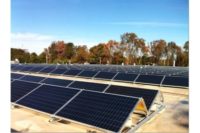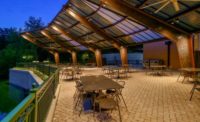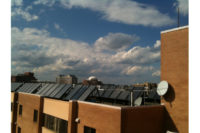Solar Challenge: Innovation Makes Unique Solar Panel Installation Possible

Silverback Solar’s engineering department was able to utilize as much roof space as possible for solar panels by elevating them above HVAC equipment with the Silverback Solar racking system.

The layout and design of the solar panels depended on the ability of the Silverback Solar team to work around solar lights, skylights and HVAC equipment. It was all made easier by the versatility the company’s adjustable sprocket.

A shot from the inside of the facility, showing the existing truss system to which the Silverback Solar racking system had to be attached.



A barrel roof with HVAC equipment and skylights is not the ideal platform for a crystalline panel solar system, but a watertight attachment system from Silverback Solar allows architects, engineers and contractors to work with such challenges.
As part of a major renovation seeking net-zero energy LEED certification, DPR Construction of San Francisco wanted to install solar panels on its roof to generate electricity for use within its downtown office. The remodel also included natural lighting and a new energy-efficient HVAC system.
“This project is 118 kW, which is equal to about 26 residential solar systems,” said Sam Kim, sales engineer for Vista Solar, a California-based company that designs, engineers, finances, installs and maintains commercial solar systems. “Our energy production goal for this project is 158,000 kWh in the first year. Normally this production ratio would be no problem, but this building is in an urban area in downtown San Francisco with buildings shading the roof on three sides.”
Vista Solar encountered a number of unique challenges during the install. First, taller buildings on three sides of the DPR Construction offices required the arrays to be elevated to a level where the sun could hit them. Second, the roof has two large atriums, several skylights, HVAC units and 16 Solatube skylights. “Not only are these objects taking up space on the roof for solar, but the fire guidelines that require pathways to and clearances around these objects further reduced the usable space we had on the roof,” Kim said. “With a typical flat roof ballasted system, we could simply design modules to wrap around these objects, but that wasn’t an option available to us because of the surrounding buildings and the barrel roof construction.”
Finally, the truss engineering of the roof dictated very specific loading points to attach the solar system. They were at 20 foot spans, so the racking solution required had to be able to handle 20-foot spans, at elevation, with minimal part count, no field welding and have the versatility to accommodate site changes for newly installed solar tubes.
Engineering and unique innovation from Silverback Solar went a long way to helping complete this curved roof solar project. “Not only was Silverback able to deliver the needed solutions, but the engineers at Silverback were able to work with our team to help create some custom attachments that allowed us to work around an HVAC unit and maximize the system capacity for the client,” said Kim.
Silverback Solar’s mounting system features a roof attachment system that creates a completely watertight structural mounting point. It also features a patented adjustable sprocket to allow adjustments with the curvature of the roof.
“The Silverback product is both lightweight and durable, which makes the building of the racking easy and faster to install than other similar racking systems,” said John Bruce, general foreman for Vista Solar. “The ability to adjust the bracing and supports makes the racking very adaptable to varying roof terrains. More importantly, there was no cutting of materials since the racking comes precut and bundled per array, which is also identified per location on the site layout from Silverback. Each part is labeled alphabetically, so all we needed to do is use a measuring tape, protractor to confirm our pitch, and a 5/16 impact driver to install the self-drilling screws to hold the brackets to the pipe, and most of all, know your ABC’s. With these simple requirements, we were able to build this racking with maximum production and minimal waste.”
According to Bruce, the Silverback Base Mounts were installed at truss-supported locations. After all the mounts were installed, the tops of the base mounts were wrapped with plastic bags to protect them from the overspray of the foam roofing material. The foam roof was then sprayed throughout the roof and about the base mounts. After the foam roof was completed, the bags were removed from the mounts. Crews then installed the top bracket that mounts onto the base mount and started building the structure.
Staging and assembly was a challenge on the barrel roof, but was made easier by the Silverback Solar framing and attachment system. Late changes to the HVAC equipment and solar lighting layout kept Bruce’s crew on its toes.
“The most challenging parts of this project are the roof itself, the constant uphill climb due to the dome roof, and not being able to stage materials except for minimal space that is close to a flat surface on the peak of the dome,” Bruce said. “Working around skylights and HVAC was probably more challenging on the design and engineering side. Sam was able to keep up with the ongoing changes with the solar tube layout and HVAC locations that were affecting our installation. Silverback was able to work with Sam to provide the necessary engineering and design support throughout the installation, which allowed me to build with the right materials and the pre-engineered design to meet those site challenges.”
“Our racking and design team provided the perfect solution for this solar installation” said Silverback Solar Project Manager Kristina SanSo. “It was a challenging project, but this kind of thing is what we do best.”
“This was an extremely complicated design and engineering project,” Kim said. “We had weekly meetings leading up to the install to ensure that all the moving parts were working with each other. Of course, as in all construction projects, we had new challenges to overcome, but with a stellar engineering and support team consisting of our in-house team and the folks at Silverback, we were able to deal with most of them pre-installation and quickly make the field adjustments required to get the job done.”
For more information, visit www.silverbacksolar.com.
Looking for a reprint of this article?
From high-res PDFs to custom plaques, order your copy today!








